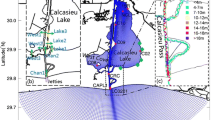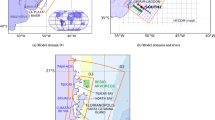Abstract
We have investigated the spreading of river water in Suruga Bay by performing numerical experiments and conducting field surveys with drifting buoys. There are clear seasonal variations in the large river discharges into the bay: increased discharge in the rainy summer season and decreased discharge in the dry winter season. The numerical model reproduces the main feature that has been observed in the actual sea: the river water extends gradually from the northwestern to the southeastern regions in the bay, especially in summer. The river water spreading is greatly influenced by the bottom topography of the bay: the Fuji River water spreads over a deep continental slope as a surface-advected plume and extends well offshore, since a large bulge (anticyclonic eddy at the river mouth) extends well offshore and effectively transports the river water offshore. On the other hand, the Oi River water tends to flow parallel to isobaths (along a coastline) on a shallow continental shelf as a bottomadvected plume. Moreover, the influences of seasonal variations in the stratification and a bay-scale, wind-driven circulation are also investigated. Trajectories of the drifting buoys, which were released around the Fuji River mouth, certainly suggest that the bulge exists there.
Similar content being viewed by others
References
Endoh, M. (1977): Formation of thermohaline front by cooling of sea surface and inflow of the fresh water. J. Oceanogr. Soc. Japan, 33, 6–15.
Garvine, R. W. (1999): Penetration of buoyant coastal discharge onto the continental shelf: A numerical model experiment. J. Phys. Oceanogr., 29, 1892–1909.
Garvine, R. W. (2001): The impact of model configuration in studies of buoyant coastal discharge. J. Mar. Res., 59, 193–225.
Guo, X. and A. Valle-Levinson (2007): Tidal effects on estuarine circulation and outflow plume in the Chesapeake Bay. Cont. Shelf Res., 27, 20–42.
Hagiwara, N. and T. Mizushima (2003): The influence of river discharge of the water quality of the coastal waters of Suruga Bay. J. Sch. of Mar. Sci. and Tech. Tokai Univ. (Tokai Daigaku Kiyo Kaiyogakubu), 56, 1–14 (in Japanese).
Hickey, B. M., L. J. Pietrafesa, D. A. Jay and W. C. Boicourt (1998): The Columbia River plume study: Subtidal variability in the velocity and salinity fields. J. Geophys. Res., 103, 10339–10368.
Inaba, H. (1981): Circulation pattern and current variations with respect to tidal frequency in the sea near the head of Suruga Bay. J. Oceanogr. Soc. Japan, 37, 149–159.
Inaba, H. (1982): Relationship between the oceanographic conditions of Suruga Bay and locations of the Kuroshio path. Bull. Coastal Oceanogr. (Engan Kaiyo Kenkyu Noto), 19, 94–102 (in Japanese).
Ishigami, K., Y. Michida, T. Komatsu and K. Tanaka (2006): Accumulation mechanism of drifting seaweeds in the eastern Suruga Bay based on surface drifter. Proc. Techno-Ocean 2006/19th JASNAOE Ocean Engineering Symposium, 113 pp.
Isobe, A. (2005): Ballooning of river-plume bulge and its stabilization by tidal currents. J. Phys. Oceanogr., 35, 2337–2351.
Katsumata, T. (2004): Intrusion process of oceanic water to Suruga Bay. Ph.D. thesis, Graduate School of Marine Science and Technology, Tokai Univ., Shizuoka, Japan, 110 pp. (in Japanese).
Kutsuwada, K., M. Tanikawa, Y. Hagiwara and T. Katsumata (2007): Long-term variability of upper oceanic condition in Suruga Bay and its surrounding area. Oceanography in Japan (Umi-no-Kenkyu), 16, 277–290 (in Japanese).
Madsen, O. S. (1977): A realistic model of the wind-induced Ekman boundary layer. J. Phys. Oceanogr., 7, 248–255.
Matsuno, T. and Y. Nagata (1987): Numerical study of the behavior of heated water discharged into the ocean. Part 1: the effect of Earth’s rotation. J. Oceanogr. Soc. Japan, 43, 295–308.
Matsuno, T. and Y. Nagata (1989): Numerical study of the behavior of heated water discharged into the ocean. Part 2: parameter dependence. J. Oceanogr. Soc. Japan, 45, 34–44.
Matsuyama, M. and T. Teramoto (1985): Observations of internal tides in Uchiura Bay. J. Oceanogr. Soc. Japan, 41, 39–48.
McCreary, J. P. and S. Zhang (1997): Coastal circulations driven by river outflow in a variable-density 1 1/2-layer model. J. Geophys. Res., 102, 15535–15554.
Minato, S. (1983): Geostrophic response near the coast. J. Oceanogr. Soc. Japan, 39, 141–149.
Nagata, Y., Y. Kitamura, Y. Michida and I. Fukumori (1983): Experimental study using rotating tank on Coriolis effect on the behavior of heated water discharged into the ocean. Proc. Coast. Eng. (Kaigan Kougaku Ronbunshu), Jpn. Soc. Civil. Eng., 30, 531–535 (in Japanese).
Nakamura, Y. (1972): Hydrographic studies in the Suruga Bay—I. A characteristic of oceanographic structures in autumn. Bull. Shizuoka Pref. Fish. Exp. Stn. (Shizuoka Suishi Kenhou), 5, 1–20 (in Japanese).
Nakamura, Y. (1973): Oceanographic structure in Suruga Bay—Status in early spring, 1970—. Bull. Japan. Soc. Fisheries Oceanogr. (Suisan Kaiyo Kenkyu), 22, 96–104 (in Japanese).
Nakamura, Y. (1982): Oceanographic feature of Suruga Bay from view point of fisheries oceanography. Bull. Shizuoka Pref. Fish. Exp. Stn. (Shizuoka Suishi Kenhou), Spec. No. 17, 1–153 (in Japanese).
Nakamura, Y. and H. Muranaka (1979): Pemporal fluctuation of oceanographic structure in Suruga Bay and Enshu-Nada. Bull. Japan. Soc. Fisheries Oceanogr. (Suisan Kaiyo Kenkyu), 34, 128–133 (in Japanese).
Nakamura, Y. and H. Muranaka (1984): Environmental survey. p. 13–29. In Research Report of Measures for Increase of Sergestid Shrimp (Sakura-ebi Zousyoku Taisaku), ed. By Shizuoka Prefecture, Shizuoka Prefectural Fisheries Experiment Station, Sizuoka (in Japanese).
Niiler, P. P., A. S. Sybrandy, K. Bi, P. M. Poulain and D. Bitterman (1995): Measurements of the water-following capability of holey-sock and TRISTAR drifters. Deep-Sea Res. I, 42, 1951–1964.
Pacanowski, R. C. and S. M. Griffies (2000): MOM 3.0 Manual. Geophysical Fluid Dynamics Laboratory/National Oceanic and Atmospheric Administration, 680 pp.
Satoh, C., Y. Isoda and M. Shimizu (2003): Clockwise circulation in the upper layer of Funka Bay in summer. Bull. Coastal Oceanogr. (Engan Kaiyo Kenkyu), 40, 181–188 (in Japanese).
Sawamoto, M. and J. Murakoshi (1985): Analysis of effluents from river mouth by using LANDSAT-MSS data. Tech. Rep. Civil Eng., Tokyo Inst. Tech. (Tokyo Kogyo Daigaku Doboku Kogakka Kenkyu Hokoku), 34, 1–29 (in Japanese).
Sekine, Y., A. Kinoshita and Y. Matsuda (1988): Aerial observations of the plumes of main rivers in Kanto and Tokai Ditricts. Bull. Coastal Oceanogr. (Engan Kaiyo Kenkyu Noto), 25, 165–176 (in Japanese).
Smagorinsky, J. (1963): General circulation experiments with the primitive equations: I. The basic experiment. Mon. Wea. Rev., 91, 99–164.
Stevens, D. P. (1990): On open boundary conditions for three dimensional primitive equation ocean circulation models. Geophys. Astrophys. Fl. Dyn., 51, 103–133.
Takahashi, Y., S. Wada and M. Koba (2001): A study on development of a regional water budget simulation model for total evaluation of hydrographic processes. J. Mitsubishi Res. Inst., 38, 52–75 (in Japanese).
Tanaka, K., Y. Michida and T. Komatsu (2007): A numerical experiment on ocean circulations forced by seasonal winds in Suruga Bay. Coast. Mar. Sci., 31(1), 30–39.
Tanaka, K., Y. Michida and T. Komatsu (2008): Numerical experiments on wind-driven circulations and associated transport processes in Suruga Bay. J. Oceanogr., 64, 93–102.
Unoki, S. and N. Okami (1985): Coastal currents in Suruga Bay and Enshu-nada deduced from LANDSAT MSS images. Bull. Japan. Soc. Fisheries Oceanogr. (Suisan Kaiyo Kenkyu), 47-48, 1–10 (in Japanese).
Whitney, M. M. and R. W. Garvine (2005): Wind influence on a coastal buoyant outflow. J. Geophys. Res., 110, doi:10.1029/2003JC002261.
Yankovsky, A. E. and D. C. Chapman (1997): A simple theory for the fate of buoyant coastal discharge. J. Phys. Oceanogr., 27, 1386–1401.
Author information
Authors and Affiliations
Corresponding author
Rights and permissions
About this article
Cite this article
Tanaka, K., Michida, Y., Komatsu, T. et al. Spreading of river water in Suruga Bay. J Oceanogr 65, 165–177 (2009). https://doi.org/10.1007/s10872-009-0016-x
Received:
Revised:
Accepted:
Published:
Issue Date:
DOI: https://doi.org/10.1007/s10872-009-0016-x




